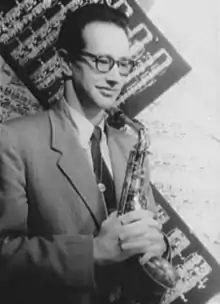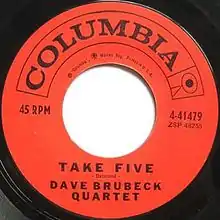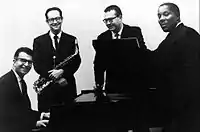Take Five
"Take Five" is a jazz standard composed by saxophonist Paul Desmond and originally recorded by the Dave Brubeck Quartet for their album[lower-alpha 1][2] Time Out at Columbia Records' 30th Street Studios in New York City on July 1, 1959.[3] Two years later it became a surprise[4] hit[lower-alpha 2] and the biggest-selling jazz single ever.[5][6] Revived since in numerous movie and television soundtracks,[7] the piece still receives significant radio airplay. The single was inducted into the Grammy Hall of Fame in 1996.

Musical style
"Take Five" is known for its distinctive two-chord[lower-alpha 3] piano/bass vamp; catchy,[lower-alpha 4] cool-jazz saxophone melodies; inventive, jolting drum solo;[lower-alpha 5] and unorthodox quintuple (5
4) time, from which Dave Brubeck derived its name.[9][10]
Helped by native symphony musicians, the classically-trained Brubeck had recently enhanced his knowledge of more complex forms of music during the Quartet's U.S. State Department-sponsored tour of Eurasia in the spring of 1958.[11] The odyssey inspired him to create an album that diverged from the usual 4
4 or 3
4 time of jazz by adapting the exotic meters he had encountered abroad.[12]
Composing, arranging and recording
| "Take Five" | ||||
|---|---|---|---|---|
 | ||||
| Single by Dave Brubeck Quartet | ||||
| from the album Time Out | ||||
| B-side | "Blue Rondo à la Turk" | |||
| Released | September 21, 1959; reissued May 22, 1961 | |||
| Recorded | July 1, 1959 CBS 30th St. Studios, New York | |||
| Genre | West Coast cool jazz | |||
| Length | 2:55 (single version) 5:28 (album version) | |||
| Label | Columbia | |||
| Songwriter(s) | Paul Desmond (composer) | |||
| Producer(s) | Teo Macero | |||
| Dave Brubeck Quartet singles chronology | ||||
| ||||
Following repeated requests to Brubeck from the Quartet's drummer, Joe Morello, for a new piece to showcase his facility with 5
4 time, Desmond unwittingly "lucked out... like keno" when Brubeck delegated his saxophonist to contribute a composition in that meter to the Time Out album, using Morello's rhythm.[13] Desmond delivered two melodies,[lower-alpha 6] which Brubeck arranged in ternary form.[15]
Recording "Take Five" proved so torturous for the Quartet that, after 40 minutes and more than 20 failed attempts, producer Teo Macero suspended the first recording session of June 25, 1959 because one or another of the members kept losing the beat. They finally cut the single and album tracks at the next session on July 1.[16]
Structure
"Take Five" is written in the key of E♭ minor, in ternary (ABA) form and in 5
4 time. Rhythmically, the five beats to the bar are split unevenly into 3 + 2 quarter notes; that is, the main accents (and chord changes) are on the first and fourth beats. The album version has ten sections:[17][18]
| Section | Description |
|---|---|
| Intro | Drum enters, joined by piano after 4 bars and bass after 8 bars to set up 5 4 rhythm with syncopated two-chord (E♭m–B♭m7} vamp |
| AA | Alto sax plays main melody (A), based on E♭-minor hexatonic blues scale,[lower-alpha 7] in two similar 4-bar phrases |
| BB | Alto sax plays bridge melody (B), based on G♭-major scale, in two similar 4-bar phrases |
| AA | Reprise |
| Solo 1 | Alto sax plays improvised modal[19] solo, based on E♭-minor hexatonic blues scale,[lower-alpha 8] over vamp[lower-alpha 9] |
| Solo 2 | Drum plays improvised solo, halfway through which the vamp abruptly crescendoes before fading to low volume as solo ends |
| AA | Reprise, heralded by intro vamp played softly before alto sax swiftly rejoins |
| BB | Reprise |
| AA | Reprise |
| Tag | Alto sax plays repeated 4-note riffs from main melody with final note sustained for 3 bars over vamp |
Release and chart success
Although released as a promotional[21] single on September 21, 1959,[lower-alpha 10] "Take Five" fulfilled its chart potential only when reissued[lower-alpha 11] for radio play and jukebox use[23] in May 1961, that year reaching No. 25 on the Billboard Hot 100 (October 9),[24][lower-alpha 12] No. 5 on Billboard's Easy Listening chart (October 23)[25] and No. 6 on the UK Record Retailer chart (November 16).[26] The single is a different recording from the LP version and omits most of the drum solo.[27] It became the first jazz single to surpass a million in sales,[28] reaching two million by the time Brubeck disbanded his 'classic' quartet in December 1967.[29]
Columbia Records also enlisted "Take Five" in their doomed launch of the 33 1⁄3-rpm stereo single in the marketplace. Together with a unique stereo edit of "Blue Rondo à la Turk", they pressed the full album version in small numbers for a promotional six-pack of singles sent to DJs in late 1959.[30][31]
Performances

The Dave Brubeck Quartet first played "Take Five" for a live audience at the Newport Jazz Festival on July 5, 1959.[20] Over the next 50 years the group re-recorded it many times, and typically used it to close concerts: each member, upon completing his solo, would leave the stage as in Haydn's Farewell Symphony until only the drummer remained ("Take Five" having been composed to feature Morello's mastery of 5
4 time).[5][9][32]
Some of the many cover versions include lyrics by Brubeck's wife Iola, penned for a September 6, 1961 live recording[lower-alpha 13] sung by Carmen McRae backed by the Dave Brubeck Trio (Brubeck, Eugene Wright and Morello).[33][34] Al Jarreau recorded an acclaimed scat version of the song for NDR television in Hamburg, West Germany on October 17, 1975.[35]
Desmond, upon his death from lung cancer in 1977, left the performance royalties for his compositions, including "Take Five", to the American Red Cross,[36][37] which has since received royalties averaging well over $100,000 a year combined.[38][39]
Personnel
Cover versions
The piece has been a staple of jazz and pop music since it was first released. More than 40 cover versions have been recorded, as early as Carmen McRae's cover in 1961 on an album titled Take Five Live. Recordings have been released by artists known for playing jazz (Elek Bacsik, Al Jarreau, George Benson), country (Chet Atkins), bluegrass (The String Cheese Incident) and pop (Stevie Wonder), as well as from artists in many countries. In 1972, singer Don Partridge wrote lyrics to "Take Five" sung to the saxophone melody, and regularly performed the song in live stage performances and when street-busking throughout Europe.[40] A 1968 cover by Val Bennett (retitled "The Russians Are Coming")[41] became the theme of British television series The Secret Life of Machines in the late 1980s. In 1995, Moe Koffman recorded a version for his album Devil's Brew. This was the first version recorded by a Canadian artist. In 1996, The Specials recorded a version for their cover album Today's Specials. In 2011, a version by Pakistan's Sachal Studios Orchestra won widespread acclaim and charted highly on American and British jazz charts.[42] Jazz pianist Jacky Terrasson included the song in his 2015 album Take This.[43]
Notes
- The single version was recorded separately the same day.[1]
- Nominated for the 1962 Grammy Award for Record of the Year, won by Henry Mancini for "Moon River".
- E♭m-B♭m7
- Desmond believed the borderline decision to include his bridge melody was key to the tune gaining popularity.[8]
- Featured in the album version but not the single.
- Desmond's second, bridge melody converts the first five notes of the song "Sunday, Monday or Always" (a 1943 chart-topper for Bing Crosby) into a rhythmically-altered four-note hook,[14] repeated during a chord progression that descends diatonically (C♭7-B♭m7-A♭m7-G♭7).
- With one added note, F♮.
- With two added notes, F♮ and C♮. In contrast, Crist (2019) describes the solo as based on the B♭-minor Aeolian scale[19] with one added note, A♮ (the 'blue note' of the E♭-minor hexatonic blues scale).
- There is an edit in the album track at 2:00 (4 bars after the saxophone solo ends), perhaps to remove a piano solo or to splice the two best solos together.[20]
- Almost three months before its parent album Time Out was itself released.
- Partly in response to heavy rotation of the tune on radio station WNEW in New York City.[22]
- Its parent album Time Out, likewise reissued in 1961, peaked on November 27 that year at No. 2 on the Billboard Monaural LPs chart, behind only Judy at Carnegie Hall by Judy Garland.
- Made at the Basin Street East nightclub in New York City.
References
- Crist, Stephen A. (2019-09-04). Dave Brubeck's Time Out. Oxford University Press. p. 117. ISBN 978-0-190-21772-3. Retrieved 2020-01-31.
- Russonello, Giovanni (2020-12-07). "'Take Five' Is Impeccable. 'Time Outtakes' Shows How Dave Brubeck Made It. - An album of previously unheard recordings from the "Time Out" sessions in 1959 reveals the making of a masterpiece". The New York Times. Retrieved 2020-12-09.
- Schudel, Matt (2012-05-12). "Dave Brubeck, 'Take Five', and his longtime collaborator credited with the jazz legend's biggest hit". The Washington Post. Archived from the original on 2015-07-23.
- Ramsey, Doug (2005-02-01). Take Five: The Public and Private Lives of Paul Desmond. Seattle: Parkside Publications. p. 210. ISBN 978-0-9617266-7-6. Retrieved 2020-08-17.
- "Dave Brubeck". Encyclopædia Britannica. Retrieved 2015-05-16.
- Kniestedt, Kevin. "The Mix: 100 Quintessential Jazz Songs". National Public Radio. Retrieved 2016-06-05.
- Alatorre, Michael (2016-03-19). "Same Song, Different Movie: Take Five by the Dave Brubeck Quartet". le0pard13.com. Retrieved 2020-01-30.
- Ramsey, Doug (February 1, 2005). Take Five: The Public and Private Lives of Paul Desmond. Seattle: Parkside Publications. p. 208. ISBN 978-0-9617266-7-6. Retrieved 2020-01-26.
- Sarabia, Tony (2000-11-19). "The Story Of Dave Brubeck's 'Take Five'". National Public Radio. Archived from the original on 2017-10-17. Retrieved 2020-02-15.
- Canter, Andrea (2008-05-20). "Take "Time Out" for Dave Brubeck: At Orchestra Hall, May 25th". Jazz Police. Archived from the original on 2010-01-17. Retrieved 2011-01-18.
- Schudel, Matt (2008-04-06). "Ambassador of Cool". washingtonpost.com. Retrieved 2018-06-12.
- Kaplan, Fred (2009). 1959: The Year that Changed Everything. John Wiley & Sons. pp. 130–131. ISBN 978-0-470-38781-8.
- Ramsey, Doug (2005-02-01). Take Five: The Public and Private Lives of Paul Desmond. Seattle: Parkside Publications. p. 207. ISBN 978-0-9617266-7-6. Retrieved 2020-01-26.
- Giddins, Gary (2018-10-30). Bing Crosby: Swinging on a Star: The War Years, 1940-1946. Little, Brown. ISBN 978-0-316-41235-3. Retrieved 2020-08-17.
- Ramsey, Doug (2005-02-01). Take Five: The Public and Private Lives of Paul Desmond. Seattle: Parkside Publications. p. 208. ISBN 978-0-9617266-7-6. Retrieved 2020-01-26.
- Stephen A. Crist (2019-09-04). Dave Brubeck's Time Out. Oxford University Press. p. 117. ISBN 978-0-19-021771-6. Retrieved 2020-08-17.
- Lawn, Richard J. (2013). Experiencing Jazz. Routledge. p. 237. ISBN 9781135042684.
- Barnes, Austin Lee (2012). Analysis of selected percussion literature: Concerto for vibraphone and orchestra by Ney Rosauro, Surface tension by Dave Hollinden, Urban sketches for percussion trio by Lon W. Chaffin, "Take Five" by Paul Desmond, and DT supreme by Austin Barnes (PDF) (Report). Manhattan, Kansas: Kansas State University. Archived from the original on 2017-10-17.
- Crist, Stephen A. (2019-09-04). Dave Brubeck's Time Out. Oxford University Press. p. 108. ISBN 978-0-19-021773-0. Retrieved 2020-09-19.
- Clark, Philip (2020-02-18). Dave Brubeck: A Life in Time. Hachette Books. ISBN 978-0-306-92165-0. Retrieved 2020-08-26.
- Crist, Stephen A. (2019-09-04). Dave Brubeck's Time Out. Oxford University Press. p. 190. ISBN 978-0-190-21772-3. Retrieved 2020-06-15.
- "Best Selling Jazz Albums". Billboard. 28 April 1962. p. 12. ISSN 0006-2510. Retrieved 2020-06-10.
- Crist, Stephen A. (2019-09-04). Dave Brubeck's Time Out. Oxford University Press. p. 191. ISBN 978-0-190-21772-3. Retrieved 2020-06-15.
- "Dave Brubeck Chart History". Billboard.com. Retrieved 2018-06-11.
- "Dave Brubeck Take Five Chart History". Billboard.com. Retrieved 2018-06-11.
- "Official Singles Chart Top 50 1961". Officialcharts.com. Archived from the original on 2017-08-01. Retrieved 2017-04-21.
- Schaap, Phil (1999). Soundtrack to a Century – Jazz: The Definitive Performances (Liner notes). Sony Music Entertainment, Columbia/Legacy. J2K 65807.
- Tawney, Raj (2019-12-13). "The Dave Brubeck Quartet's 'Time Out' at 60: Inside Jazz's First Million-Selling LP". billboard.com. Retrieved 2020-06-15.
- Feather, Leonard (1967-07-30). "The End of an Era in Modern Jazz". Los Angeles Times.
- "The Dave Brubeck Quartet / Billy Butterfield & Ray Conniff – Take Five / South Of The Border". Discogs.com. n.d. Retrieved 2020-01-30.
- Callahan, Mike (2016-02-13). "The Stereo Singles Project, Part 2: Stereo-33 Singles Discography (1959-1964)". bsn.com. Both Sides Now Publications. Retrieved 2020-01-30.
- Thursby, Keith (2011-03-14). "Joe Morello dies at 82; jazz drummer for Dave Brubeck Quartet". Los Angeles Times. Archived from the original on 2017-10-17. Retrieved 2015-05-16.
- Ted Gioia (2012). The Jazz Standards: A Guide to the Repertoire. Oxford University Press. p. 419. ISBN 978-0-19-976915-5.
- "Dave Brubeck Discography". jazzdisco.org. Free Software Foundation. 2001. Retrieved 2020-01-25.
- Meeker, David (2019-04-29). "NDR Jazz Workshop 1975". Loc.gov. Retrieved 2020-02-01.
- Gioia, Ted (2012-09-27). The Jazz Standards: A Guide to the Repertoire. p. 419. ISBN 9780199937400.
When Paul Desmond passed away in 1977, his will stipulated that royalties form this song and his other compositions go to the American Red Cross. Since then, the Red Cross has received more than $6 million from Desmond's bequest.
- Lees, Gene (1995-12-21). Cats of Any Color: Jazz Black and White. Oxford University Press. p. 55.
- Doyle, Brian (2004-01-25). Spirited Men: Story, Soul & Substance. Lanham, MD: Cowley Publications. p. 90. ISBN 9781461733034.
The proceeds from his compositions and from his recordings were sent to the American Red Cross, which now earns more than $100,000 a year from his music. In the twenty-four years since his death, Paul Desmond has given the Red Cross more than three million dollars.
- "Paul Desmond – Celebrating a Legacy of Music and Compassion". American Red Cross. 2005. Retrieved 2016-11-12.
- Stewart Partridge, brother
- Thompson, Dave (2002) Reggae & Caribbean Music, Backbeat Books, ISBN 0-87930-655-6, p. 392
- Walsh, Declan (2011-08-05). "Jazz album by Pakistan music veterans storms western charts". The Guardian. Pakistan. Archived from the original on 2017-03-08.
- Collar, Matt. "Take This - Jacky Terrasson | Songs, Reviews, Credits | AllMusic". AllMusic. Retrieved 25 September 2020.